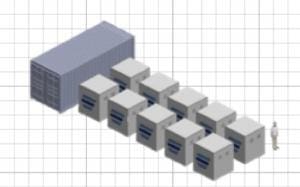Promising grid-scale battery technology startup Ambri has recently completed its third round of funding, bringing its unique liquid metal battery closer to full-scale commercialisation.
Ambri raised a total of USD $35 million of venture capital in its latest round of funding, building on the USD $15 million funding it attracted in 2012 from the likes of Khosla Ventures, Bill Gates, Total (energy company) and others. The funds will enable Ambri to build its first commercial-scale manufacturing plant for liquid metal batteries and deliver commercial battery systems to customers.
Ambri’s unique liquid metal battery technology, which was first developed at MIT by CTO David Bradwell and MIT professor Donald Sadoway, is a radically different design compared to lithium-ion, flow-batteries and other large scale storage technologies. The battery consists of two molten metal layers (electrodes) separated by a layer of molten salt (the electrolyte) sealed inside a cell. The system operates at elevated temperatures and is self-heating during normal operation. Cells are strung together into systems, which are modular in size based on customer needs (see image below).
The Ambri System is modular. Above is a 2 MWh system with 1 MW peak power capacity. (Image Credit: Ambri)
Since the electrolyte and electrodes are all in a liquid state, the battery avoids common failure mechanisms seen in other batteries and does not lose its charge-holding capacity with time. The result is a battery that lasts 25-30 years and loses only 2% of its charge-holding capacity after a whopping 10,000 charge-discharge cycles. Grid-storage lithium batteries, in comparison, last about half as long and lose more than 20% of the their storage capacity by their end of life.
Further, the Ambri batteries have no moving parts, pumps or valves and are made using earth-abundant materials, making them cheap to manufacture. Andrew Chung from Khosla Ventures, a key funding partner of Ambri, claims the manufacturing costs and labour requirements for Ambri’s batteries are, in fact, lower than that of lithium-ion batteries.
This “simplicity” and “elegance” of Ambri’s battery technology is expected to translate to a low total cost of ownership, which is “what will drive the energy storage market” according to Chung. Professor Sadoway adds that Ambri’s pricing is expected to fall between that of pumped hydro and compressed-air energy storage, potentially making it cost competitive with other non-battery storage solutions.
In addition to upscaling manufacturing and improving its technology, Ambri will use the new funds to deliver commercial systems to customers, which includes project partners such as First Wind, Hawaiian Electric, and ConEdison. An example is the prototype grid storage system being developed for Hawaii, where over 30% of wind energy production is currently being dumped due to a mismatch in grid supply and demand. Ambri’s systems are expected to improve integration of solar power and reduce wind curtailment.
If Ambri’s prototype projects perform as hoped, the latest round of funding will see Ambri build a new plant for even bigger systems (up to 2 MWh) and move into commercialization by late 2016.
Top Image Credit: Ambri via Forbes
© 2014 Solar Choice Pty Ltd
- Future of Utilities – Part 1: The death of base-load generators - 11 September, 2014
- Sharp enters energy storage market with SmartStorage - 18 August, 2014
- Phinergy extends electric car range with metal-air battery technology - 13 August, 2014

It is my understanding that grid scale liquid metal batteries are aimed at supplementing/backing up the grid in case of generator breakdown.
This seems to me to assisting the continuation of the existence of highly polluting electrical generators rather than replacing them.
I cannot see why these cannot replace the grid. It was mentioned in Donald Sadoway’s TED Video that container sized batteries may be able to supply power for up to 200 homes.
In this case why can’t these be centered on groups of 200 houses each house having solar panels charging up the batteries. Then the reverse during overnight to provide power to the homes. I am sure it would only be a matter of sizing.
Why are we fixed at maintaining the grid with all the pollution, scarring of the countryside with pylons and transmission lines etc.
It would also seem to me that distribution would be cheaper as homes usually already have to have under ground cables for the provision of electricity. Why can’t these simply be connected to a local liquid metal battery.
I’ve been following this for a while. Do you happen to know…
– Whether Sadoway’s battery is likely to end up in homes (rather than being better deployed municipally or regionally etc)?
– If so, what a unit for an average house would cost, and what capacity it would need to flatten the demand of a home electricity supply?
Regards, Bruce Thomson in New Zealand.
Hi Bruce,
Thanks for commenting. Ambri’s solution would more likely be for grid-scale/utility use than for home use. For now, lithium-ion & lead acid batteries remain the most popular choice for residential applications thanks to their cost & relative scalability.